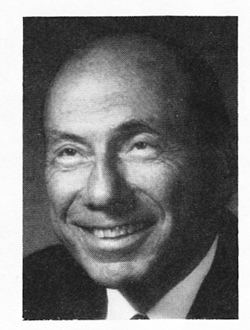THE EDITOR'S CORNER
Approximately 1600 orthodontic auxiliaries attended the annual meeting of the American Association of Orthodontists in Atlanta this year and there was an excellent program especially for them. The size of the attendance and the interest and participation of the auxiliaries in the program suggests that there is a growing group of dedicated, career-oriented team members in orthodontics. It also indicates a growing interest on the part of employer-orthodontists to encourage such an attitude among their employees. It is an extremely healthful development for orthodontics.
In the recent JCO Orthodontic Practice Study, 64% of the respondents reported staff turnover of 36 months or less, meaning that the average employee remained in the practice three years or less. In addition to the disruption of the office when an employee leaves, the stress it places on those who remain, and the time it takes to bring a new employee up to the standard of the office, there have been various estimates - ranging from $4000 to $8000 - for the actual cost of lost productivity.
Not only to reduce turnover, but also to build an efficient and effective, highly motivated, career-oriented, working team, orthodontists ought to be concerned with what makes employees tick--what things contribute to their satisfaction on the job, what motivates them to work, and what their attitudes are toward their work.
A possible breakthrough in this area was the insight of Frederick Herzberg that job satisfaction and job dissatisfaction are not opposites. He conducted surveys attempting to identify factors affecting workers' attitudes on the job and contributing to their satisfaction or dissatisfaction on the job. He concluded that these factors were:
1. Achievement.
2. Recognition.
3. Work itself.
4. Responsibility.
5. Advancement.
6. Growth.
7. Company policy and administration.
8. Supervision.
9. Interpersonal relations.
10. Working conditions.
11. Salary.
12. Status.
13. Security.
From these, he developed his Motivation-Hygiene Theory in which he called the first six factors "motivating factors" and the last seven factors "hygiene factors". The motivating factors have the potential to make workers happy and satisfied on the job. The hygiene factors are maintenance factors, which must be at a satisfactory level. Above that level they are not additionally motivating, but below that level they can be sources of unhappiness and dissatisfaction on the job. In other words, as Herzberg puts it: "What makes people happy is what they do or the way they are utilized, and what makes people unhappy is the way they are treated."
Other studies have not supported Herzberg's conclusions and the problem is one of method. Herzberg used a critical-incident method in which the subject is asked to name a specific incident that was a source of satisfaction or dissatisfaction on the job. Others use a rating scale method, which Herzberg believes to be unreliable because people may tend to give answers that they think others will expect or approve, or they may give ratings to items that they have no special opinion about.
It would be interesting to try the critical-incident method in orthodontics and compare the findings to those from a rating scale study. Rating scale studies have been done in orthodontics. Ten years ago, Jim Reynolds was surveying his audiences and others on a list of factors similar to that of Herzberg. The interesting point, at that time--if memory serves--was the difference between how employees ranked the factors and how employer-orthodontists believed their employees would rank the factors. Employees ranked "appreciation for a job well done" as first, while employers thought they would rank "salary" as first. In a recent extensive rating-scale survey of orthodontic employees, reported by Dave Hamilton, employees still rate "appreciation for a job well done" at the top of their list, but now it has risen to the top of the orthodontists' list as well.
Orthodontists may be dealing with a unique labor force. A 1980 Gallup poll reported that when workers were asked to list the most important aspects of their job, a plurality named job security, followed by job satisfaction, money/salary, and work quality, with promotion a distant last. This may also be a reflection of the rating scale method. The critical-incident method might show different results.
We have come a long way from the time when the needs of the orthodontist took precedence over the needs of staff and patients, and when state laws formalized this attitude by severely restricting the tasks that employees were permitted to do. Under those conditions, the orthodontist was preoccupied with his Number One problem--which was not how to build a practice or how to train a staff. H is N umber One problem was the efficient control of tooth movement. Concentration on that problem gave the orthodontist the idea that that was the only thing that mattered and that he was the only significant person in the practice.
We now have largely solved the problem of moving teeth efficiently, and dental practice acts now largely permit auxiliaries to perform many of the technical tasks in orthodontic practice. We are in a transition period in which many orthodontists are delegating to auxiliaries many tasks that were previously reserved for themselves, are recognizing the competency of well-chosen auxiliaries, and are shifting to a management role in which they are appreciative of the contributions of a career-oriented team to the success and growth of the practice.
There is little doubt that this has been a positive development for orthodontics. However, it raises a serious question. How will orthodontists react when orthodontic auxiliaries outnumber orthodontists at our annual meetings? How we handle that may well say a great deal about what the future practice of orthodontics will be like.


